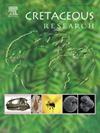First dinosaur ichnofauna from the Bauru Group indicates Cenomanian–Turonian events led to an ‘Ornithischian Hiatus’ in the Upper Cretaceous of Southeast Brazil
IF 1.7
3区 地球科学
Q1 GEOLOGY
引用次数: 0
Abstract
The Cenomanian–Turonian interval represents a critical period of faunal change during the Late Cretaceous. Although the main causes of this turnover are contentious, it is undeniable that these global events significantly influenced the last stages of dinosaur evolution. The Bauru Group in southeastern Brazil is known for its rich body-fossil record of crocodyliform and dinosaur remains, representing a key geological unit for understanding the evolution of continental biotas in the Upper Cretaceous of Gondwana. However, the ichnological record in these units are scarce, primarily consisting of invertebrate burrows and rare tetrapod traces. This study focuses on the newly discovered tracksite within the Cenomanian–Turonian Santo Anastácio Formation, marking the first dinosaur ichnofauna identified in the Bauru Group. The new ichnocoenosis includes four theropod morphotypes, a quadrupedal and a small bipedal ornithischian, bipedal and graviportal ornithopods, and a small, narrow-gauged sauropod trackmaker. These tracks provide new insights into the dinosaur faunas during the Cenomanian–Turonian interval and highlight the existence of clades not previously identified in the Bauru Group, particularly ornithischians. The absence of body fossils of these taxa in the younger strata of the Bauru Group indicates that the successive environmental fluctuations during the Cenomanian–Turonian may have been responsible for regional extinctions or migration of these animals to higher latitudes. This ecological shift might have allowed specialized crocodyliforms like sphagesaurians to fill the niches left by small herbivorous dinosaurs in the Bauru Group, while titanosaurians dominate the medium-to-large herbivore roles in these ancient ecosystems.

来自包鲁群的首个恐龙化石群表明,仙人-土伦事件导致了巴西东南部上白垩世的 "鸟臀目断代 "现象
Cenomanian-Turonian期是晚白垩世动物变化的关键时期。虽然这种更替的主要原因有争议,但不可否认的是,这些全球性事件对恐龙进化的最后阶段产生了重大影响。巴西东南部的Bauru群以其丰富的鳄鱼形和恐龙遗体化石记录而闻名,代表了了解冈瓦纳上白垩纪大陆生物进化的关键地质单位。然而,这些单位的技术记录很少,主要由无脊椎动物洞穴和罕见的四足动物痕迹组成。本次研究的重点是新发现的塞诺曼尼亚-图尔onian Santo Anastácio组的足迹遗址,这标志着在bauuru群中发现的第一个恐龙石群。新发现的恐龙群包括四种兽脚亚目恐龙,一种四足和一种小型两足鸟臀亚目恐龙,两足和重力门鸟脚亚目恐龙,以及一种小型窄脚蜥脚类恐龙。这些足迹为研究塞诺曼期-土尔onian期的恐龙群提供了新的见解,并突出了以前在保鲁群中未发现的进化枝的存在,特别是鸟目目。在bauuru群的年轻地层中没有这些分类群的身体化石,这表明在Cenomanian-Turonian期间连续的环境波动可能是这些动物区域灭绝或迁移到高纬度地区的原因。这种生态转变可能使得像食龙这样的特殊鳄鱼形动物填补了鲍鲁群中小型食草恐龙留下的空缺,而泰坦龙在这些古老的生态系统中主导着中型到大型食草恐龙的角色。
本文章由计算机程序翻译,如有差异,请以英文原文为准。
求助全文
约1分钟内获得全文
求助全文
来源期刊

Cretaceous Research
地学-地质学
CiteScore
4.10
自引率
19.00%
发文量
235
审稿时长
12 weeks
期刊介绍:
Cretaceous Research provides a forum for the rapid publication of research on all aspects of the Cretaceous Period, including its boundaries with the Jurassic and Palaeogene. Authoritative papers reporting detailed investigations of Cretaceous stratigraphy and palaeontology, studies of regional geology, and reviews of recently published books are complemented by short communications of significant new findings.
Papers submitted to Cretaceous Research should place the research in a broad context, with emphasis placed towards our better understanding of the Cretaceous, that are therefore of interest to the diverse, international readership of the journal. Full length papers that focus solely on a local theme or area will not be accepted for publication; authors of short communications are encouraged to discuss how their findings are of relevance to the Cretaceous on a broad scale.
Research Areas include:
• Regional geology
• Stratigraphy and palaeontology
• Palaeobiology
• Palaeobiogeography
• Palaeoceanography
• Palaeoclimatology
• Evolutionary Palaeoecology
• Geochronology
• Global events.
 求助内容:
求助内容: 应助结果提醒方式:
应助结果提醒方式:


